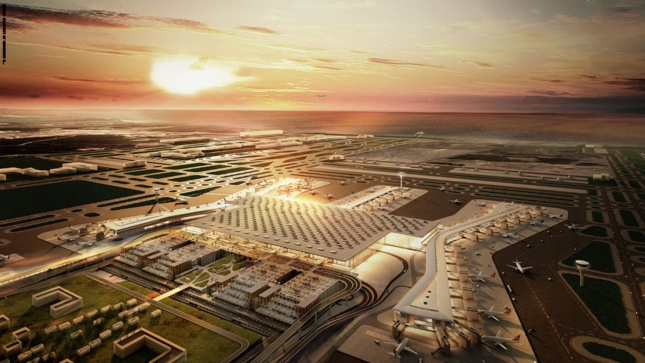Architects’ Journal and Construction News have collaborated on an investigation into the construction safety issues at Turkey’s new $12 billion Istanbul Airport, a project that resulted in an official death toll of 55 over its four-year build-out. While it’s recently come to light that there were substantial human rights violations happening on-site, this new report contributes further evidence that’s even difficult to read. It details the individual stories of several migrant workers who witnessed these deaths firsthand, as well as insight into the horrible living and working conditions there.
Considered the largest airport in the world at 818 million square feet (25 percent larger than Manhattan), the Istanbul Airport has been lauded as one of the greatest engineering feats of the last two decades. It was developed by a joint venture group called iGA, which includes several large Turkish contractors and other international companies. The airport’s design has also won numerous awards thanks to a large-scale design effort by three British firms: Grimshaw, Scott Brownrigg, and Haptic Architects, as well as Oslo-based practice Nordic, and two Turkish firms Fonksiyon and TAM/Kiklop.

Phase one of the project opened in April with three runways and 15 million square feet of terminal space. The remaining three phases are expected to be completed by 2025 and together will accommodate up to 200 million passengers annually.
Though the Istanbul Airport boasts these extreme numbers, the human cost of building the mega-structure can never outweigh its prominence on the world’s stage, according to those interviewed by AJ and Construction News. The report describes two horrific deaths, as well as primary accounts of the bed bug-ridden workers’ accommodations, the lack of running water on site, and the mistreatment of laborers by construction management. Some were silenced for simply asking about the number of screws needed for a roof panel.
#Turkey: Unions report 38 people died building the new Istanbul airport.
Behind the glass and steel of President Erdogan’s newest mega-project, 30 construction workers and a union leader are sitting in jail for protesting poor working conditions https://t.co/NnUASIrSx1 🇹🇷 pic.twitter.com/l6TvubHk5z
— Human Rights Watch (@hrw) October 29, 2018
After protests broke out in September of last year where Turkish police used violence against the workers, the situation drew international attention and received criticism from Human Rights Watch. With more eyes on the scene, it was confirmed this January that 55 people had died during construction, though AJ has found that the actual number could be as high as 400 or more.
Over the last few months, the architecture firms involved with the airport have continued to promote the project despite rumors of the workers’ conditions. Posts have gone up on social media, design work has been exhibited, and the projects have been entered for further awards. AJ questioned whether this was ethically appropriate given the deaths on-site, posing the question, “What do the workers who endured life in ‘the cemetery’–as the project was nicknamed–think of the involvement of the international architects?”
Eyal Weizman, founder of Forensic Architecture, told AJ the profession has a major problem in its constant push for publicity and larger-scale megaprojects. Global contemporary architecture, he said, exists in a disturbing “pharaonic dimension.”
“These projects are made mainly for the affluent sections of society and are built by a poorer migrant workforce under grueling conditions and schedules,” said Weizman. “A building like this should be a monument or a memorial. It should be dedicated to the casualties that its architecture and its delivery demanded.”











